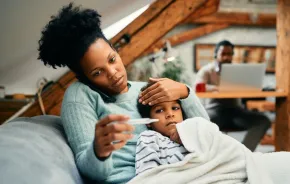
Photo:
iStock
Editor’s note: This article was sponsored by the Western Washington Medical Group.
Parents hate saying no to playdates at pet-owning friends’ homes, or watching their child get sidelined by grass or pollen allergies that act up when they’re playing outdoors. Environmental allergies can feel like an anchor, dragging a child down and keeping them from fully enjoying all the activities of childhood.
But there is good news: Kids don’t have to just suffer through allergies hoping that someday they will outgrow them. One form of treatment is a process called immunotherapy that can decrease symptoms and prevent the onset of new allergies. It requires some commitment but can help provide significant relief from allergies over time.
Amy Brookman, a physician assistant who specializes in allergy treatment at Western Washington Medical Group’s Ear, Nose and Throat clinic shares, “With environmental allergies we actually tend to grow more sensitive and tend to gain more allergies as we age, even into our twenties and thirties. By treating allergies early we can help to prevent that process.”
Pediatric allergies: Causes and symptoms
According to the CDC, nearly one-quarter of all children have some kind of allergy, most commonly environmental allergies. For many children, that means a week or two of stuffy noses and itchy eyes in the fall or spring that can be forgotten for the rest of the year.
For others, multiple sensitivities make managing symptoms and avoiding exposure to triggers more of a lifestyle than a minor inconvenience. In severe cases, the risk of a life-threatening allergic reaction (anaphylaxis) makes an allergy an extremely serious health condition.
The causes of allergies are still a mystery. There is a genetic component — children whose parents have allergies are more likely to develop allergies, too.
But allergies can appear when no one else in the family has them, and many children with allergic parents are allergy-free. Even when allergies appear across generations, the child may not be sensitive to the same triggers as their parents.
Allergy symptoms occur when the immune system responds to a benign substance as if it was a threat. This can happen the first time a person is exposed to the substance, but more often builds over repeated exposures. It’s common for people to develop new allergies as they age.
Before a child is two years old, most runny noses are the result of viral infections rather than allergies.
“Allergies really start showing around five or six years old,” says Brookman. Symptoms may still resemble a cold, including a runny nose, sneezing and itchy, watery eyes. But when these symptoms occur every year around the same time, and are accompanied by asthma, eczema, hives or dark circles under the eyes, then allergies should be considered.
Allergy testing for kids
“A lot of people go a long time without treating their allergies. Especially for little kids, parents just go off of their symptoms and it’s really common for kids to have drippy noses anyway. It can be difficult to determine if it’s allergies or a cold,” says Brookman. So allergy testing is a great option to gain a deeper understanding of what’s going on. It can help to identify what the child is allergic to, and how severely.
Inhalant allergy sensitivities can develop generally after the age of 3. For younger children, it’s common to delay testing and treat symptoms with oral antihistamines or nasal sprays.
Even if you are already sure that your child’s symptoms are the result of allergies, testing can help identify specific triggers and is a necessary step in immunotherapy. Allergy testing involves pricking the skin on the back or taking a blood test. Health care providers use the test results to establish the right concentration of allergens for a personalized immunotherapy treatment program.
How immunotherapy works
Unlike antihistamines, immunotherapy does not simply treat allergy symptoms. Through gradually increased exposure, immunotherapy desensitizes the body to allergens until they no longer trigger an immune response. Because it is a gradual process that can take up to five years, immunotherapy requires a persistent commitment on the part of the patient, but the payoff is a significant reduction in allergy symptoms long-term. It is safe for the patient to continue taking antihistamines until symptoms are reduced by the immunotherapy treatment.
There are three effective immunotherapy treatment methods: pills, shots or drops. The best course of treatment will depend on your family’s circumstances.
Prescription pills are commercially available for three of the most common allergens — grass pollen, dust mites and ragweed. Depending on which pill your child needs, they may be eligible for a prescription at age 5 or 12.
Although a daily pill is the simplest immunotherapy treatment, few people are allergic to only one allergen. When there are multiple allergies, a custom formula is developed for the patient that can be administered either by injection or through sublingual (under the tongue) drops.
Allergy shots are the most common treatment because they are usually covered by insurance. But they must be administered weekly at a medical clinic for about one year, and then monthly for at least four more years.
Generally, children who undergo immunotherapy will begin to see significant improvement in their allergies after at least six months, and can try discontinuing antihistamines by the end of the first year. Side effects from allergy shots are minor, and allergic reactions to the treatment are rare.
“I generally don’t recommend subcutaneous immunotherapy until they’re a little older, usually around age 12, because weekly shots can be challenging for a young child,” says Brookman.
The third option, and the one most recommended by Brookman, is sublingual drops. Sublingual drops are absorbed under the tongue, and children can begin treatment as soon as they can follow the directions, usually by age 5.
After taking their first dose at the clinic, sublingual drops are conveniently administered at home. Parents must be diligent about making sure doses occur every single day around the same time.
The reward for consistency is that symptoms are often improved within three to six months, and treatment can be completed within about three years. Additionally, severe allergic reactions to the drops are extremely rare.
“Generally, kids do great with sublingual drops. It’s a great option for them and much easier than the shots,” says Brookman.
Unfortunately, despite years of use in both the U.S. and Europe that indicate positive results, sublingual allergy drops have yet to complete the FDA approval process. As a result, healthcare providers cannot bill insurance for them.
That means the entire cost is out of pocket for parents. However, this disadvantage is softened by the convenience of administering the drops from home, and less needle pokes. Under some insurance plans, patients find that the total out-of-pocket cost for immunotherapy shots versus drops is comparable.
When to pursue immunotherapy
Immunotherapy treatment requires a significant commitment of time, as well as cooperation from the child. But when multiple or severe allergies interfere with their ability to engage in activities, there is no reason for a child to continue to suffer.
Besides your child’s comfort, there are additional benefits to starting immunotherapy when an allergy is first suspected. For children, treatment can relieve allergy-related asthma and eczema. In addition, immunotherapy prevents existing allergies from intensifying and developing into asthma, and can even thwart the onset of new allergies.
“If we can prevent the worsening of allergies and get ahead of it, that’s always a great route to take,” says Brookman. But even without the additional long-term health benefits, gaining the freedom to pet cats and enjoy picnics symptom-free is enough reason to treat allergies as soon as possible.












